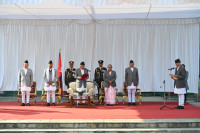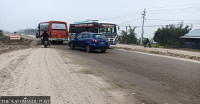National
Rising social security allowance costs cast doubt on sustainability of scheme
Number of beneficiaries doubles in 10 years, could cover 30 percent of population if all entitled are included.
Prithvi Man Shrestha
The number of people receiving cash transfers as social security allowances has nearly doubled in the last decade, thereby increasing pressure on the state coffers.
This, according to officials and experts, is a cause of concern, as such a trend would be unsustainable for the country’s economy that is already struggling to pick up pace following the Covid-19 pandemic.
According to the Department of National ID and Civil Registration, the government agency responsible for coordinating the transfer of cash for beneficiaries of social security allowances, the number of beneficiaries reached 3.06 million during the last fiscal year compared to 1.56 million in 2010-11.
The number of beneficiaries of social security entitled to get cash transferred to their accounts is around 10 percent of the country’s total population. Nepal’s estimated population as of Wednesday is 30.2 million, according to the Central Bureau of Statistics.
“If the number doubles every 10 years, it will be a huge challenge for the country’s economy,” states the department's annual report for 2019-20. In addition to the growth in the number of beneficiaries, the amount to be provided to each beneficiary has also been increased over the years.
“The amount spent on social security benefits is increasing by Rs3 to 4 billion every year,” said Jitendra Basnet, director general at the civil registration department. During the last fiscal year, the government spent Rs 66.16 billion in cash transfers to beneficiaries, according to the department.
With the government expanding the scope of beneficiaries over the years, it contributed to a massive rise in the number of beneficiaries.
The social security scheme was launched in 1994-95 by the government led by Prime Minister Manmohan Adhikari. The scheme, which started by providing Rs 100 per month to the elderly people, was gradually expanded to include single women and the differently abled in 1996-97.
Members of tribes on the verge of extinction and disabled persons were also added to the list in 2008-09. Dalit children made it to the list in 2010-11 while widows were added in 2011-12.
Dalits from the Karnali region were added to the list in 2016-17 and children from 15 districts with low human development status were made beneficiaries of cash transfers in 2018-19. The number of such districts has gone up to 26 this fiscal year.
The government still needs to include a number of groups on the list of beneficiaries as per the new Social Security Act—2018.
For example, indigent people (persons who earn less than that specified by the government by publishing a notice in the Nepal Gazette) and helpless single women who are living upon getting legal separation are yet to be included in the list of beneficiaries despite legal provision.
“Once the remaining groups of people entitled to get social security benefits as per the law are also listed as beneficiaries, the government will have to provide social security allowances for around 28-30 percent of the total population,” said Basnet.
Besides cash transfers, the government also spends on health insurance for citizens, pensions, retirement benefits, financial assistance for natural disaster victims and scholarships for targeted groups, among others.
According to experts, growing expenditure in social security amid faltering economic growth has raised concerns over its sustainability. The average economic growth in the last one decade stood at just 4.6 percent despite over six percent annual growth since the fiscal 2016-17 for three consecutive years, according to the Finance Ministry.
Due to the impact of the coronavirus, the economy is projected to have grown by just 2.7 percent against the target of 8.5 percent in the last fiscal year, according to the Central Bureau of Statistics.
The World Bank projected in its latest report released on Wednesday that Nepal’s economy would grow by just 0.6 percent in the current fiscal year, followed by 2.5 percent in the next fiscal year 2021-22.
The revenue collection of the government has been shrinking and the federal government and most of the provincial governments were forced to bring down the size of the budget for the current fiscal year compared to the last fiscal year.
“Social security is one of the factors that has increased the long-term liability for the state,” said Former Finance Secretary Shanta Raj Subedi. “The government liability to pensioners and domestic and foreign creditors has also grown massively in recent years, further increasing the liability of the state.”
In order to reduce the cost of social security, the government made an attempt to discontinue social security provisions by issuing a social security regulation in March last year.
Under the regulation, single women below 60 years of age, people with partial disability and people who are receiving remuneration, pension, retirement facility and incentives from the government and foreign government services such as ex-Indian and British Army personnel were no longer entitled to the social security allowance.
But after protests from the affected people as well as political storms created by the regulation, the government was forced to roll back the regulation, promising that the existing beneficiaries will continue to get social security benefits. The government also introduced an ordinance to ensure their benefits would not be snatched away.
Former auditor general Bhanu Acharya, however, said that the social security scheme must be tied with the state’s capability to bear long-term liability. “It is not a question of whether social security allowances should be provided but whether the state is capable of sustaining the growing cost of it,” he told the Post.
There is a tendency of increasing the social security allowances for political purposes. For example, the ruling Nepal Communist Party had promised to increase the social security allowances for senior citizens from Rs2,000 to Rs5,000 per month in their election manifesto.
Experts say that only increasing the liability without economic growth and increasing the revenue would make the scheme unsustainable.
“The government should increase internal revenue, bring the entire social security system under a single umbrella to control leakage and avoid duplication in allowance,” said Subedi. “The situation where we have to take foreign loans for social security allowance must be avoided.”
During the period between 2012 and 2016, Nepal’s spending on social protection stood at 1.7 percent of its Gross Domestic Product, which is higher than the average one percent of GDP in South Asia and the global average of 1.6 percent, according to the World Bank.
During this period, Nepal spent just 1.17 percent of its GDP in the health sector.




 10.12°C Kathmandu
10.12°C Kathmandu















